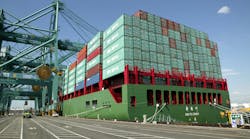Crumbling “landside” infrastructure coupled with greater traffic congestion are inhibiting the efficient flow of freight through U.S. seaports and the American economy, according to survey conducted by the American Association of Port Authorities (AAPA).
“On the land-side alone, AAPA’s U.S. member ports have identified at least $28.9 billion in needed investments by 2025,” noted Kurt Nagle, AAPA’s president and CEO, during the group’s annual spring conference being held this week in Washington D.C.
“These necessary road, rail, bridge and tunnel improvements are crucial to enable our seaports to efficiently handle their expected cargo volumes, continue providing dramatic economic and jobs impacts, and enhance America’s international competitiveness,” he said. “These ‘first and last mile’ connectors, along with other intermodal projects, are the very definition of critical transportation infrastructure.”
Some of the findings from AAPA’s 2015 State of Freight report include:
- More than one-third of respondents (38%) said congestion at their ports’ land-side connections has increased between 10% and 25% over the past decade. Another 18% of the port members polled said congestion increased between 25% and 50% over the last 10 year, with 15% indicating increases of between 50% to more than 100%t.
- One-third of respondents said congestion at their port’s land-side connectors over the past 10 years has caused port productivity to decline by 25% or more.
- Nearly a third of survey respondents said a minimum of $100 million or more must be invested in their port’s intermodal connectors through 2025. Another 18% of respondents said a minimum of $50 million is required, while 30% indicated a requirement of at least $10 million.
Nagle noted that U.S. seaports handle some $6 billion worth of goods daily, yet for ports to operate smoothly and efficiently, they must seamlessly connect commerce centers in every community, state and region.
“The fact is that while over a quarter of the U.S. economy is accounted for by port cargo activity, freight connections to our ports are crumbling, putting our economy at risk and reducing America’s competitiveness in global markets,” he stressed.
Economic research firm Martin Associates also released an updated economic impact study of U.S. seaports at AAPA’s annual gathering, which calculated that between 2007 and 2014, the total economic value that U.S. coastal ports provide in terms of revenue to businesses, personal income and economic output by exporters and importers increased 43% to $4.6 trillion.
Other findings from the 2014 National Economic Impact of the U.S. Coastal Port System include:
- Federal, state and local tax revenues generated by port-sector and importer/exporter revenues increased 51% between 2007 and 2014 to $321.1 billion;
- Jobs generated by port-related activity jumped 74% to 23.1 million;
- Personal wages and local consumption related to the port-sector doubled to $1.5 billion between 2007 and 2014, with the average annual salary of those directly employed by port-related businesses equating to $53,723.
“The growth in jobs and economic importance of America’s seaports reflects the fact that the value of international cargo [they] handle increased by $400 billion since 2007, reaching about $1.8 trillion in 2014,” John Martin, president of Martin Associates, said in a statement at AAPA’s spring meeting.
“It’s important to emphasize that the key growth in our international trade was in U.S. exports, which saw a 60% increase in value over the past seven years,” he added.
“The growth in the contributions of our ports to the nation’s economy also underscores the need to invest in infrastructure and technology to support and foster good jobs, national security, international trade and our standard of living,” Martin concluded.



